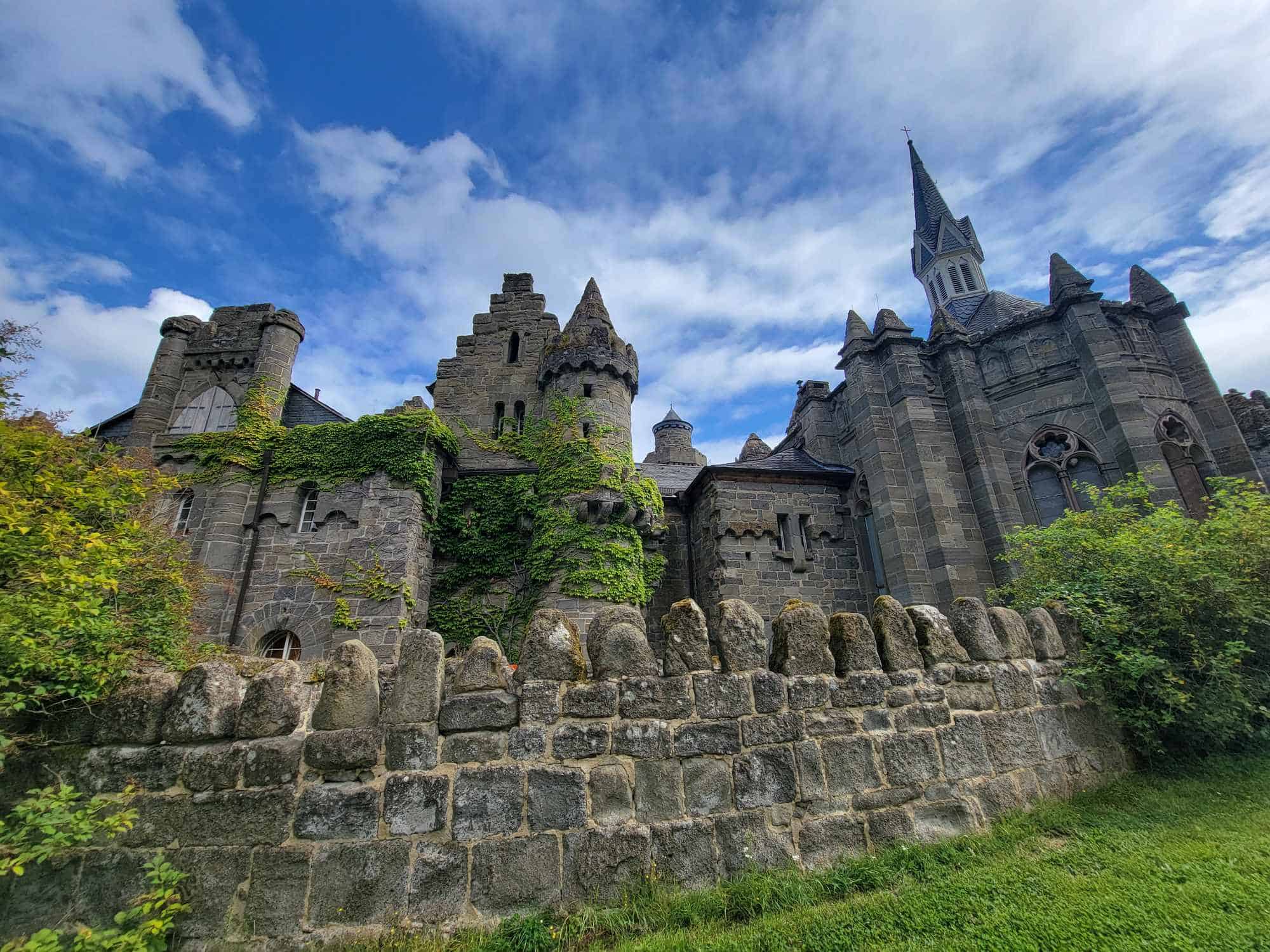If you look at Lowenburg Castle in Kassel, Germany, and think to yourself that this is one of the prettiest, most picture-perfect medieval fairytale castles you’ve ever seen, then Landgrave William IX of Hesse has achieved his goal. But the thing is, this is not a medieval castle at all! Construction on this crazy little masterpiece began in 1769, hundreds of years after the Middle Ages ended!
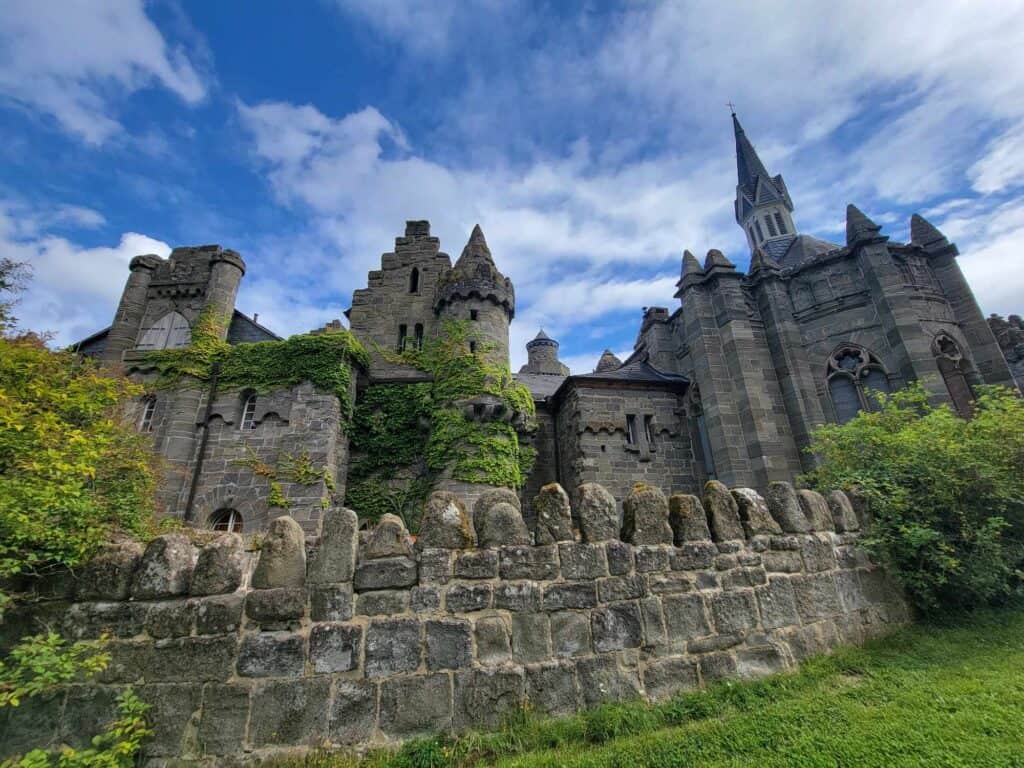
So why on earth would William have gone through all the tremendous planning, and work, and expense to build a fake medieval castle? I imagine for the same reason you and I might do it if we had piles of money and power, and thought medieval castles were pretty cool, but our families didn’t happen to own one. Think of Hearst Castle, or Neverland Ranch, or Oprah’s castle-y estate. There are lots of modern-day examples that William would have approved of.
Deliberately Building a Ruin
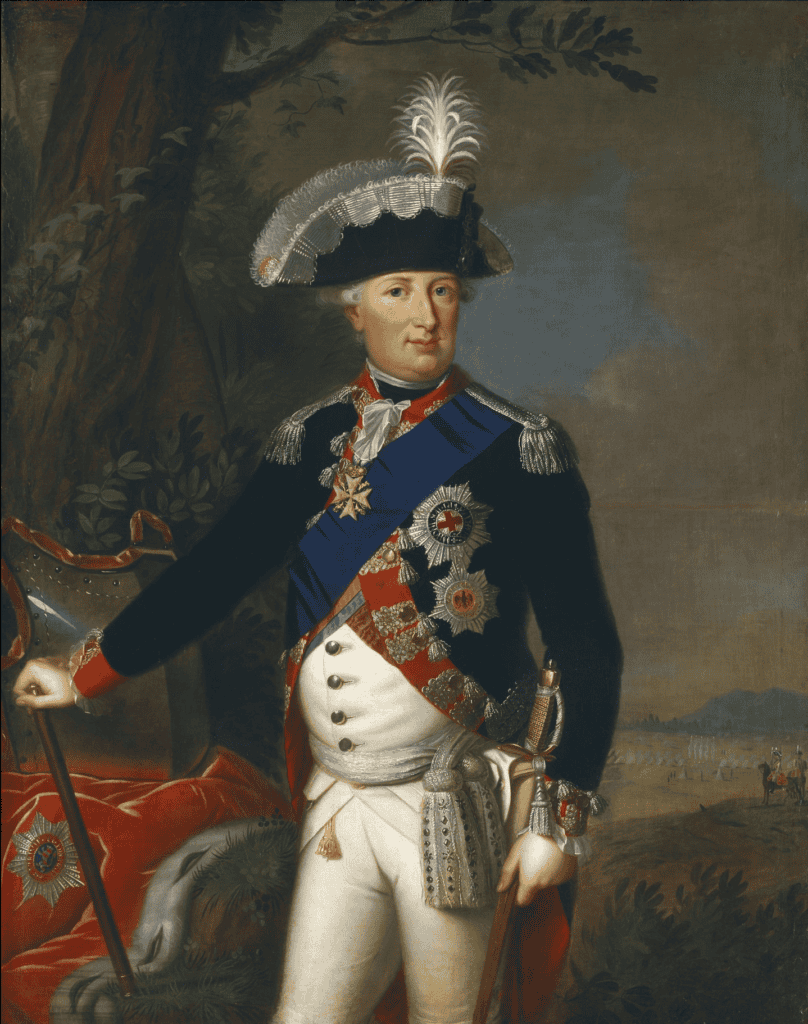
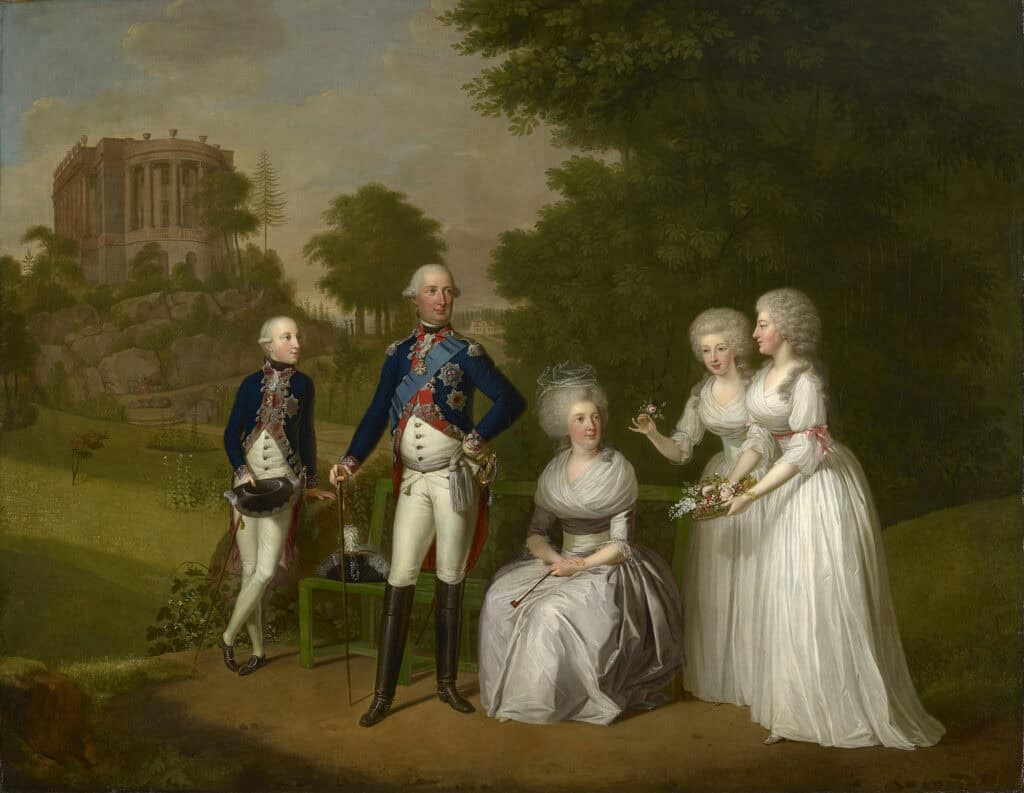
William took it even a step further. He didn’t just build the castle, he deliberately created a ruin complete with a pre-made half-collapsed tower. I wasn’t able to find anything about this for sure, but it’s interesting to note that the very famous Heidelberg castle which was a popular site to visit during William’s time has its own half-collapsed tower which could have served as inspiration.
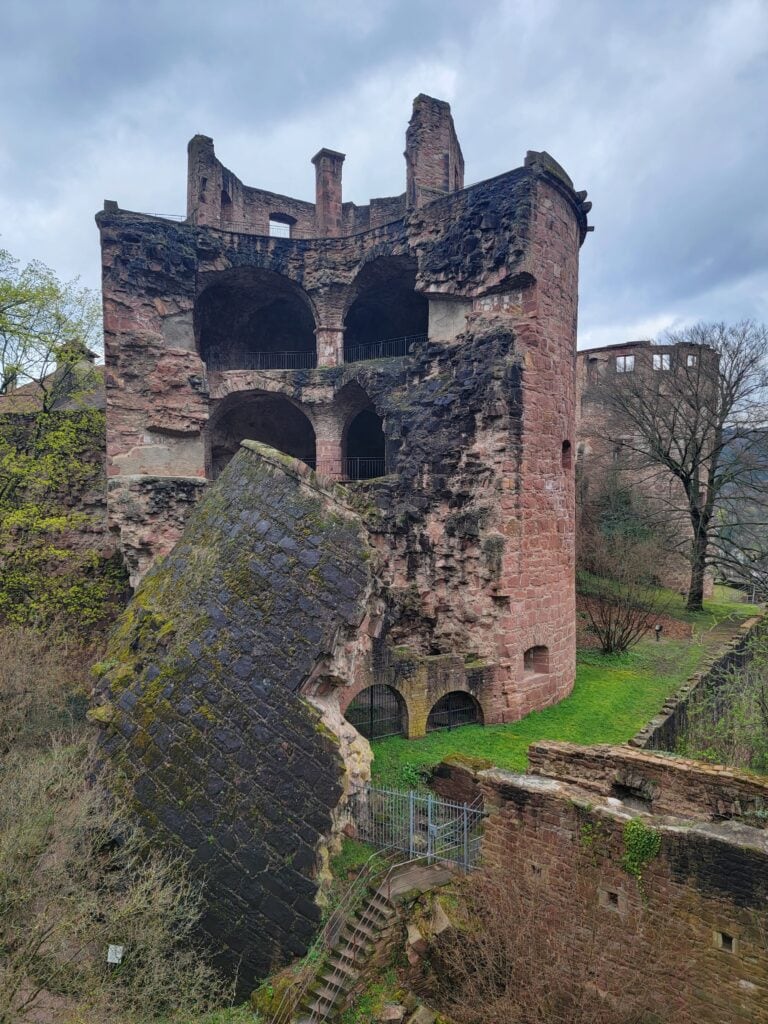
Heidelberg’s ruin wasn’t deliberate though, and was actually caused by a weakening of the foundation over time, and a lightning strike which did the final damage. Heidelberg’s tower collapsed in 1769, and Lowenburg’s construction began in 1787.
No detail was overlooked in making Lowenburg Castle a brilliant fake. In fact, there’s a carving above the southern gate that claims the castle was built in 1495! Varied window shapes, changing architectural style, and bricked-up doorways make it look like there were different construction phases – but of course, they were all built at the same time!
Romanticism
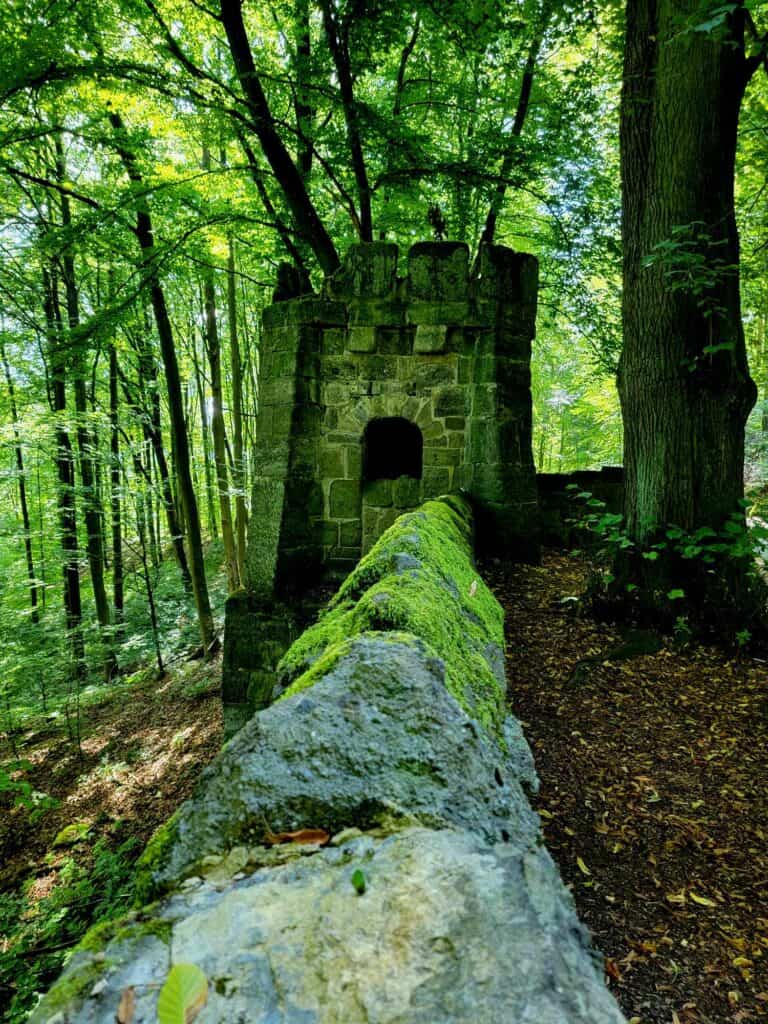
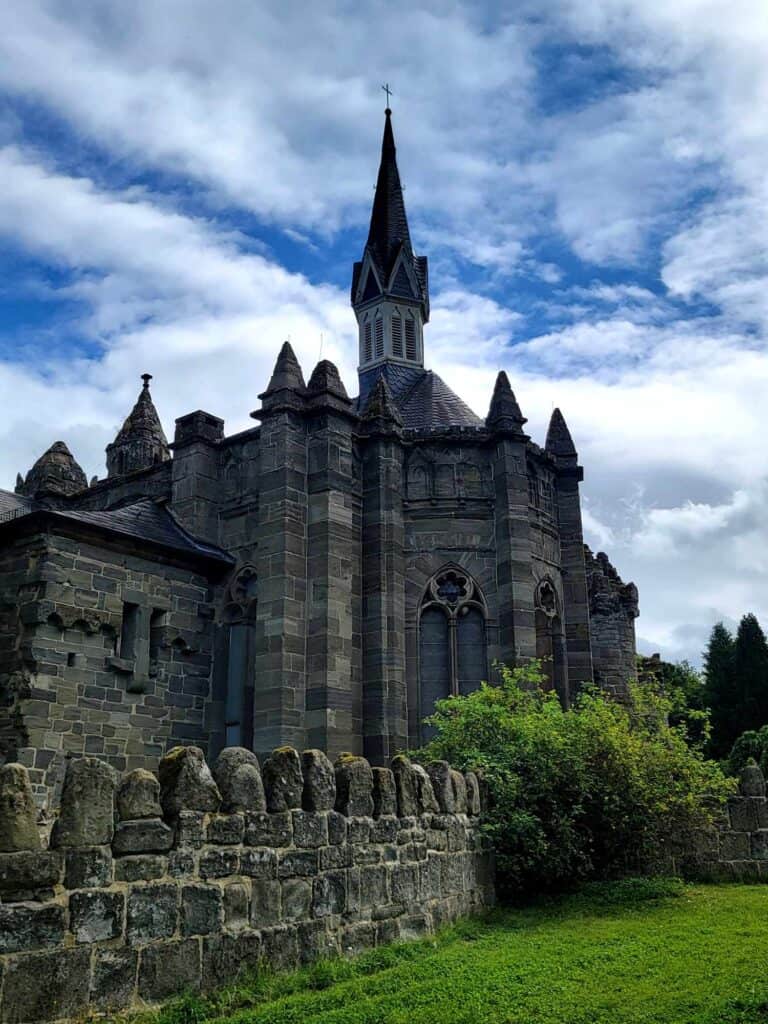
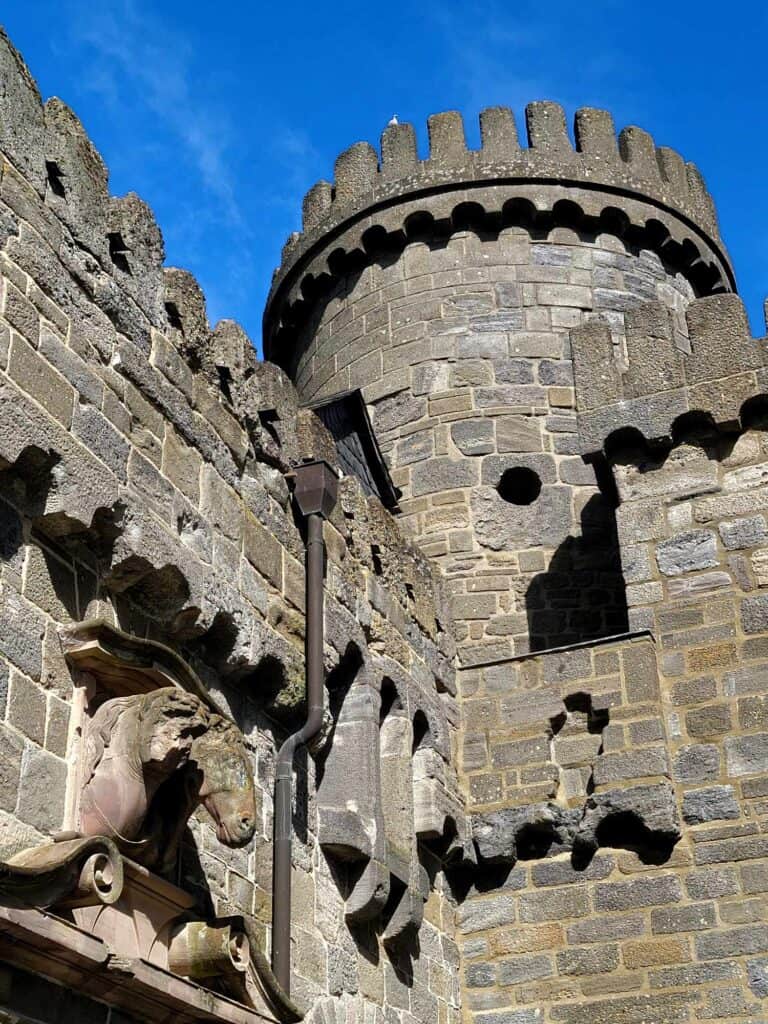
The deliberate construction of a brand new ruin was a reflection of the times, and the popularity of the Romantic movement. Romanticism celebrated and romanticized the past, particularly idealizing the medieval era. It was seen as a time of chivalry, romance, and mystery. William was a man of taste, culture, and gobs of money, so he acted on his whim and the fashion of the times, and created the castle ruin of his dreams.
The Hesse Family History
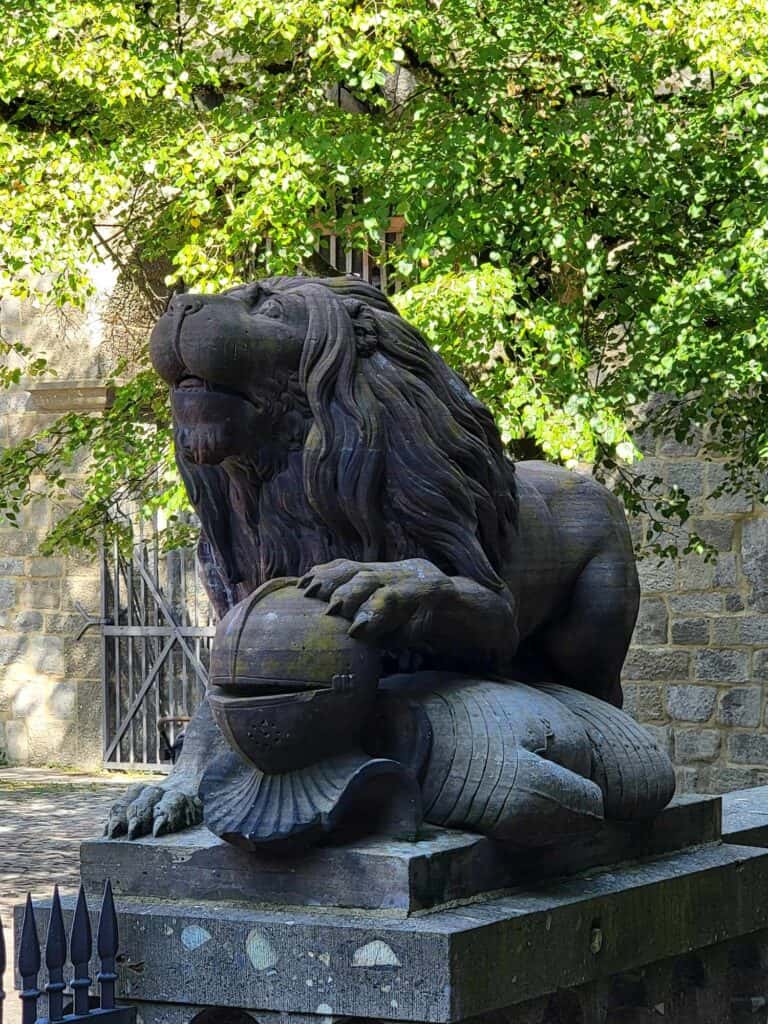
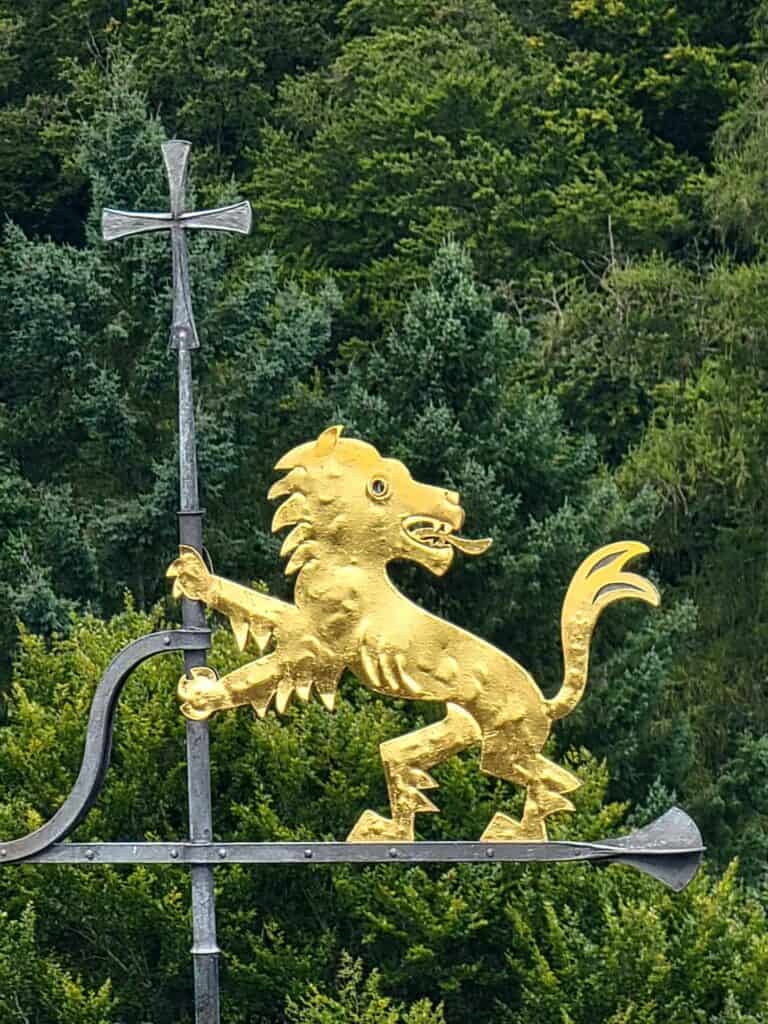
The other reason William wanted to build the castle was to remind everyone of his and his family’s history, and the power and significance of the House of Hesse, which had ruled since the Middle Ages.
The lions, which symbolized Hesse, are everywhere, including the name of the castle itself (Löwenburg = Lion Castle). He was all about prestige and demonstrating his wealth and power, and Lowenburg Castle was just one of the ways he did it.
A Calming Retreat
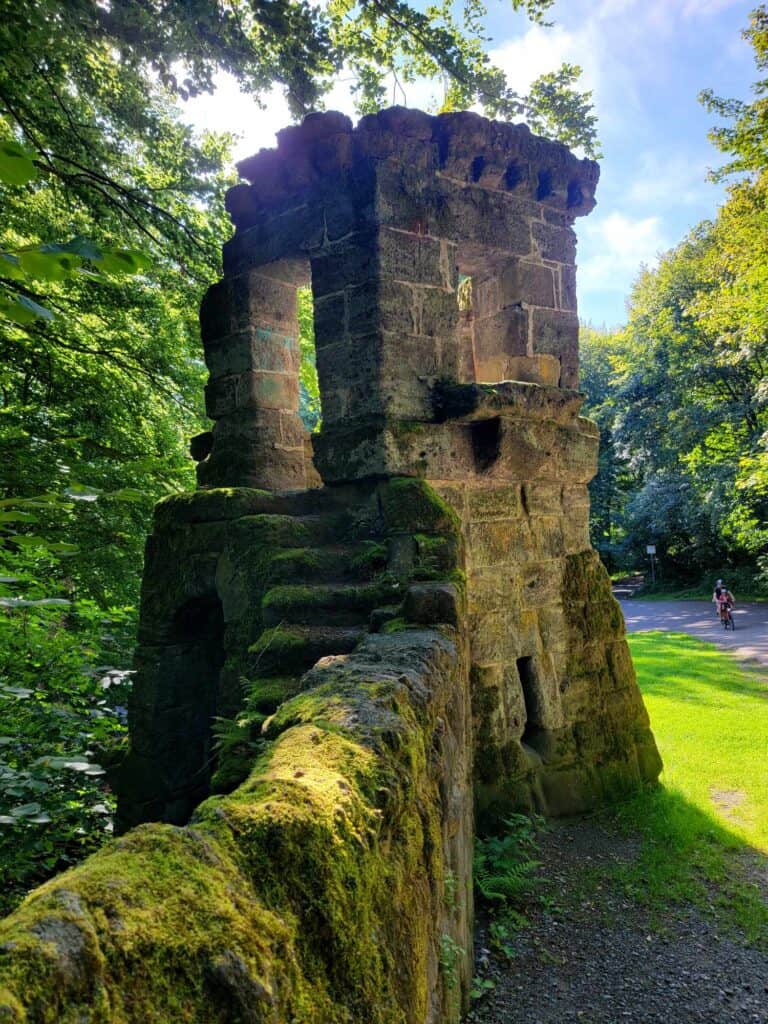
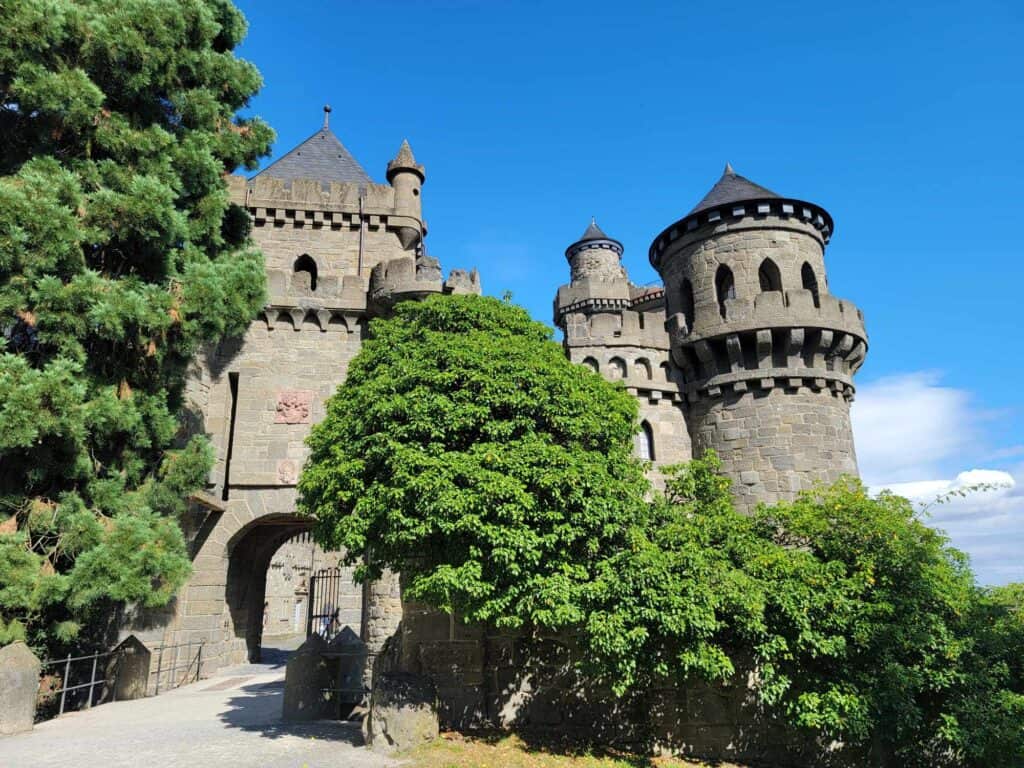
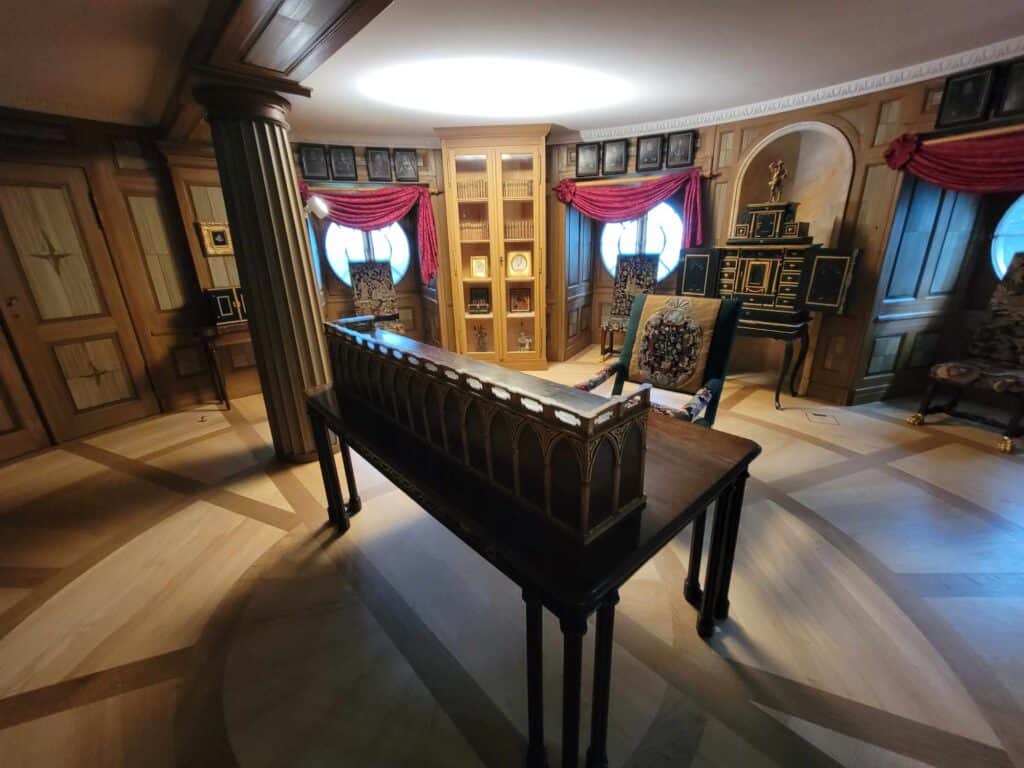
In addition to it’s role as a personal and family status symbol, the castle also served as a personal get-away for William, even though he never actually lived in it. He did live close by, and not unlike Marie Antoinette’s Petit Trianon village at Versailles, the castle provided him with a peaceful atmosphere for escaping the pressures of the court and finding inspiration in nature and the arts.
William also filled the castle with period art and furniture, gorgeous Belgian tapestries, and his servants there even wore medieval costumes. It was (and is) quite the spectacle!
Construction
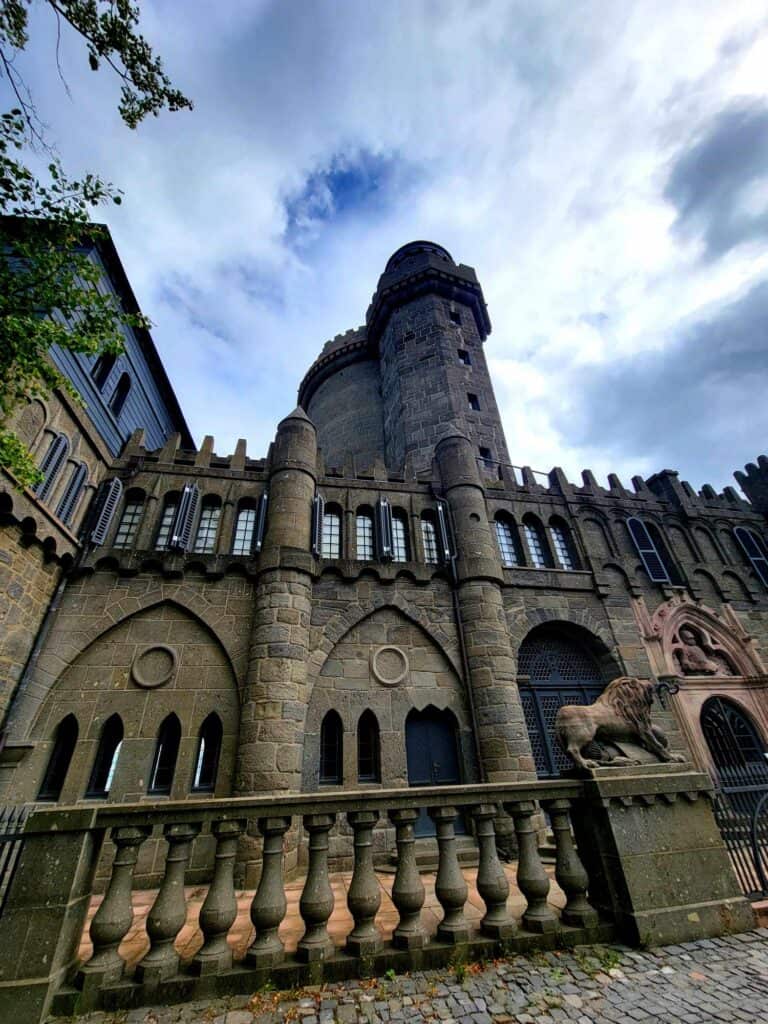
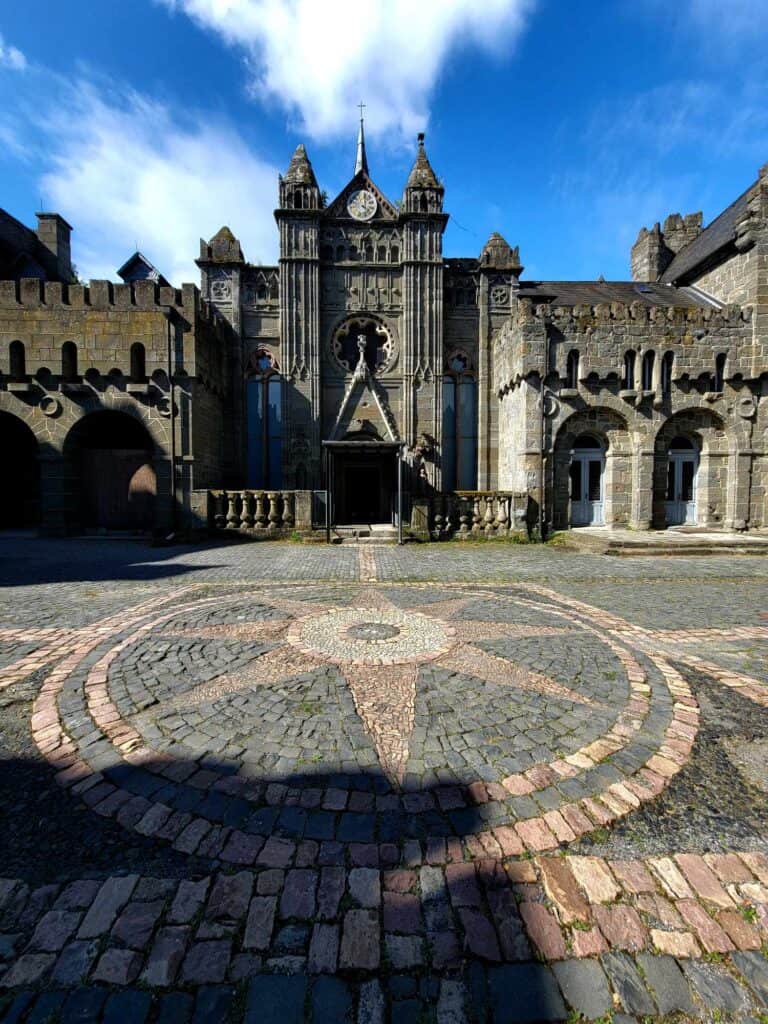
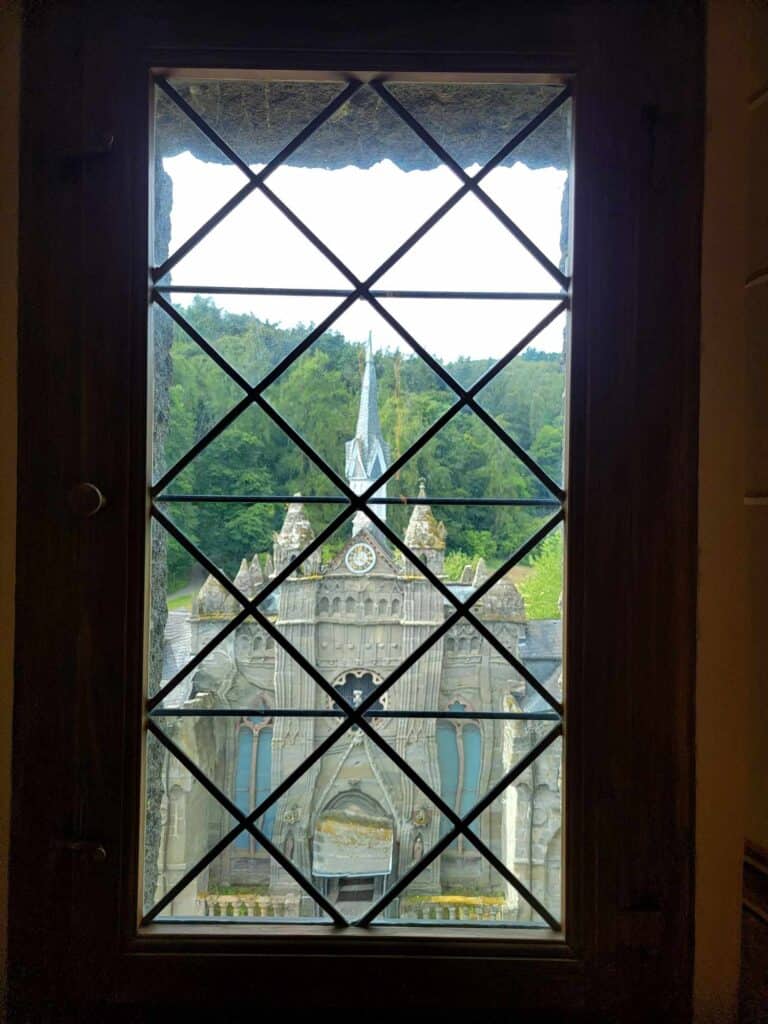
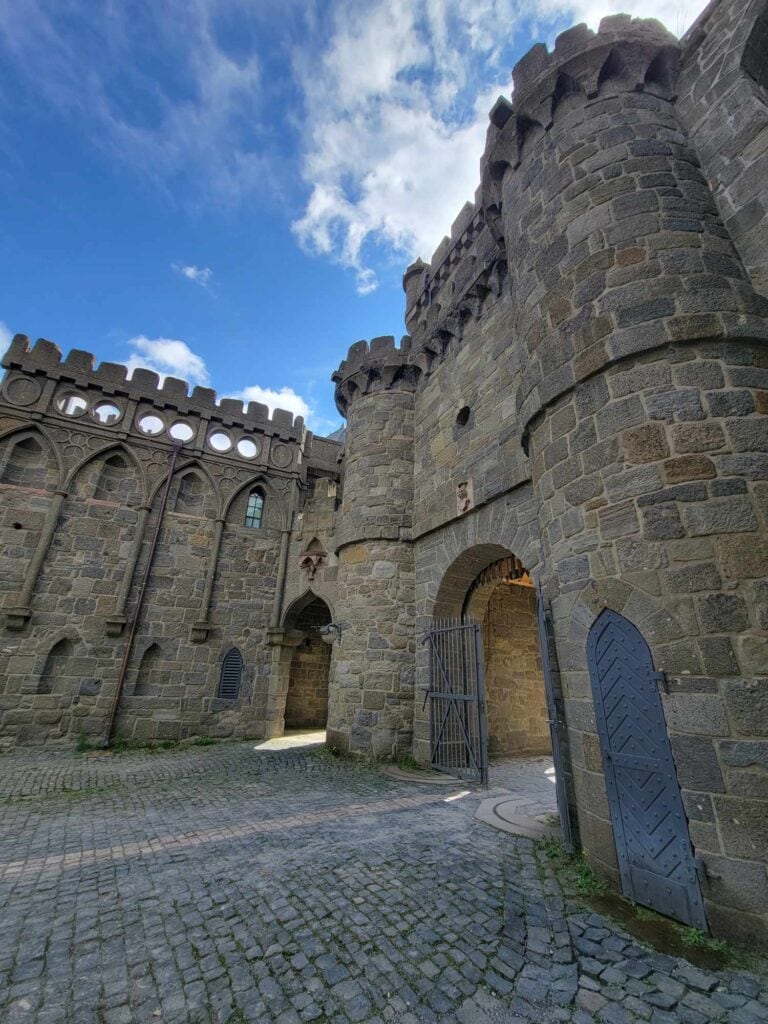


The construction of Löwenburg Castle was a painstaking and ever-changing process. The castle, just like the many castles in Hesse that were from medieval times, was built using native sandstone blocks quarried from the nearby hills. The walls were deliberately built to look rough and uneven. If the old House of Hesse had a surviving castle ruin, this is what it would have looked like in William’s mind.
Originally, the only thing planned was the keep. But the architect and designer kept getting caught up in the project, and more facets were added, more towers, more walls, more pediments and windows, an armory, drawbridges, a chapel, and eventually it ended up looking like the perfect romanticized ideal of a medieval castle.
Location
The hill where Löwenburg Castle sits had been a popular spot for hunting and recreation for the Landgraves of Hesse-Kassel. William admired French culture very much and was inspired by the grand gardens of Versailles to transform the natural beauty of his own hillside into a grand landscape garden with Lowenburg castle as part of the project. The most impressive decorative garden sculpture of all time!
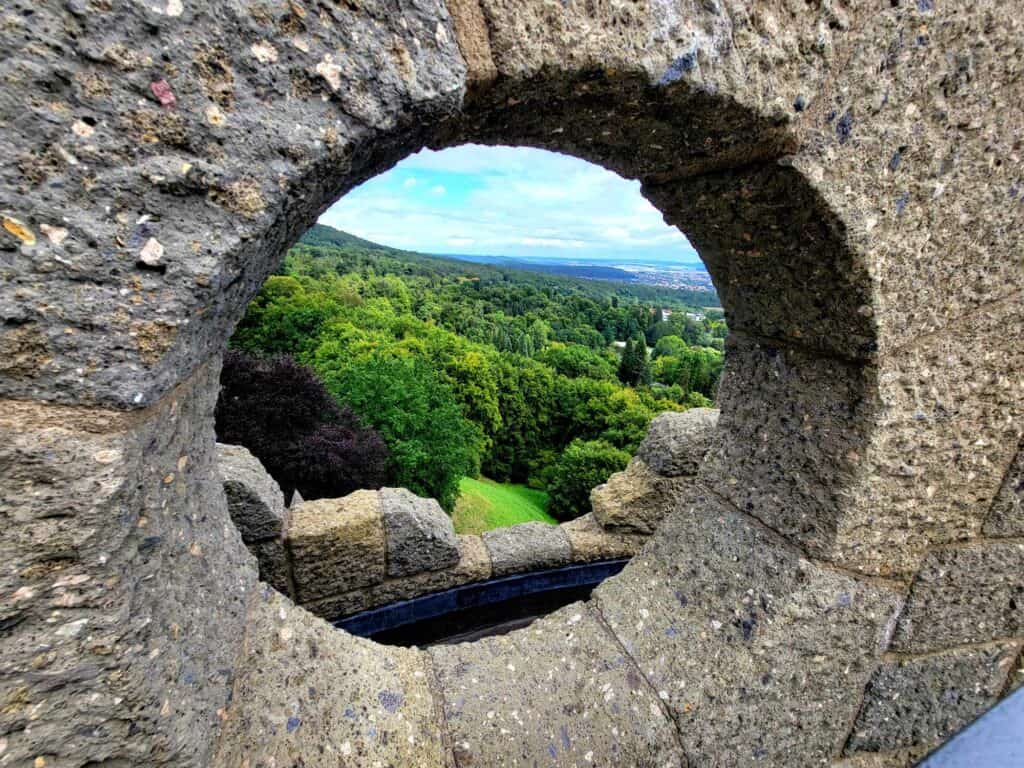
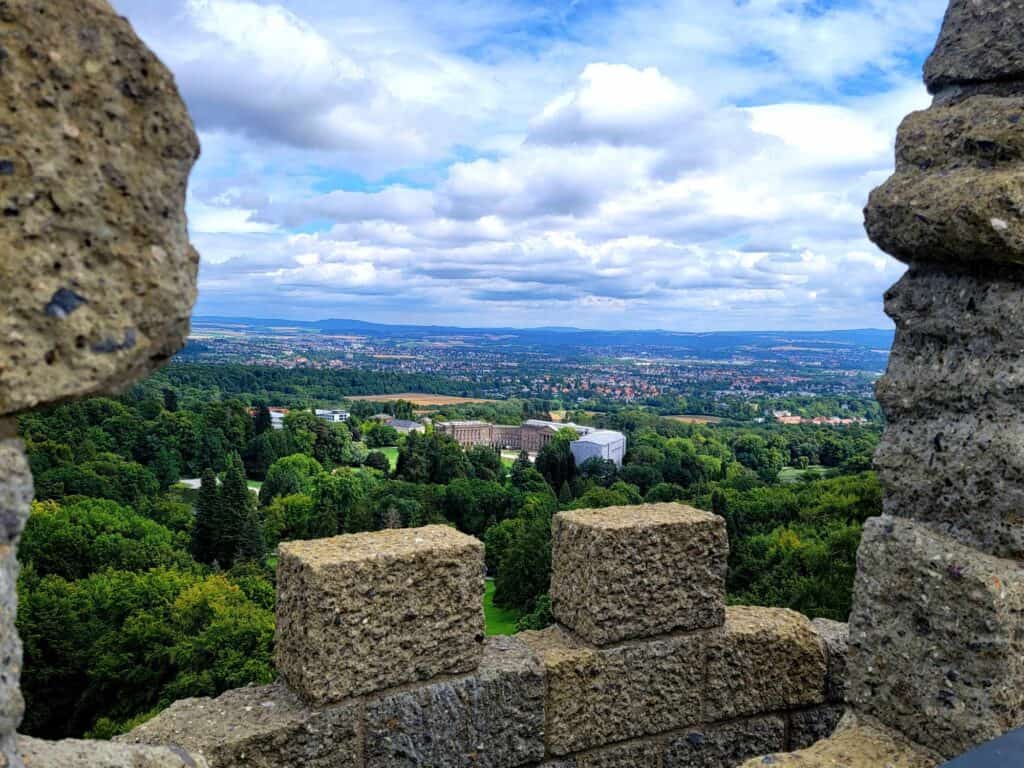
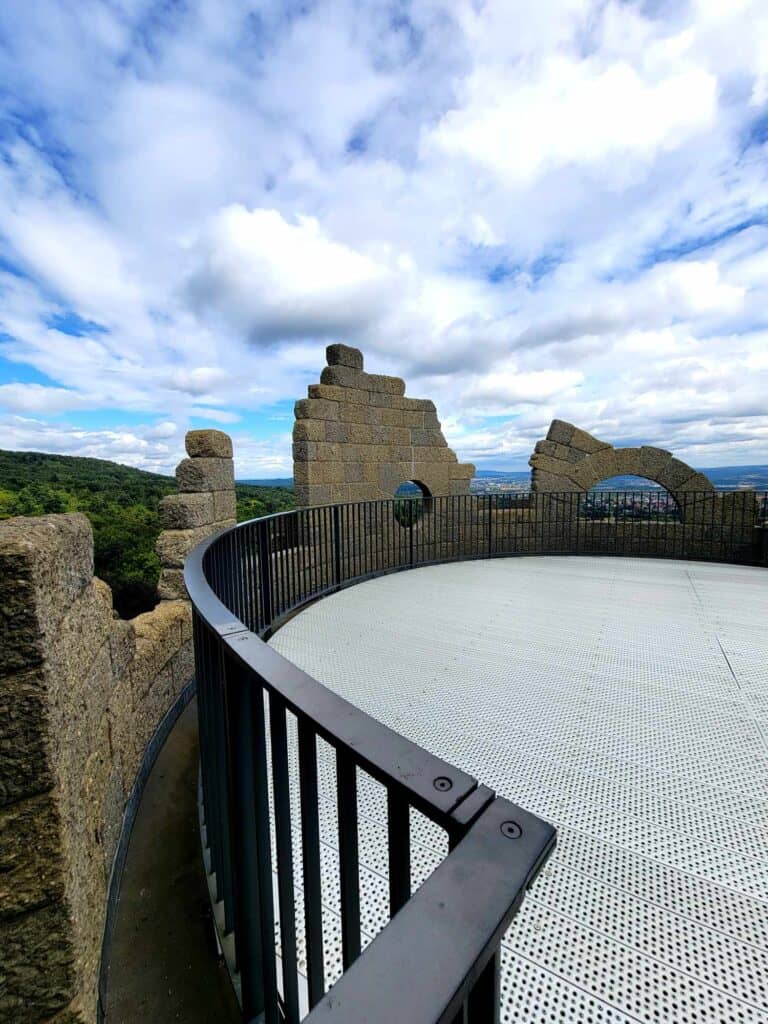
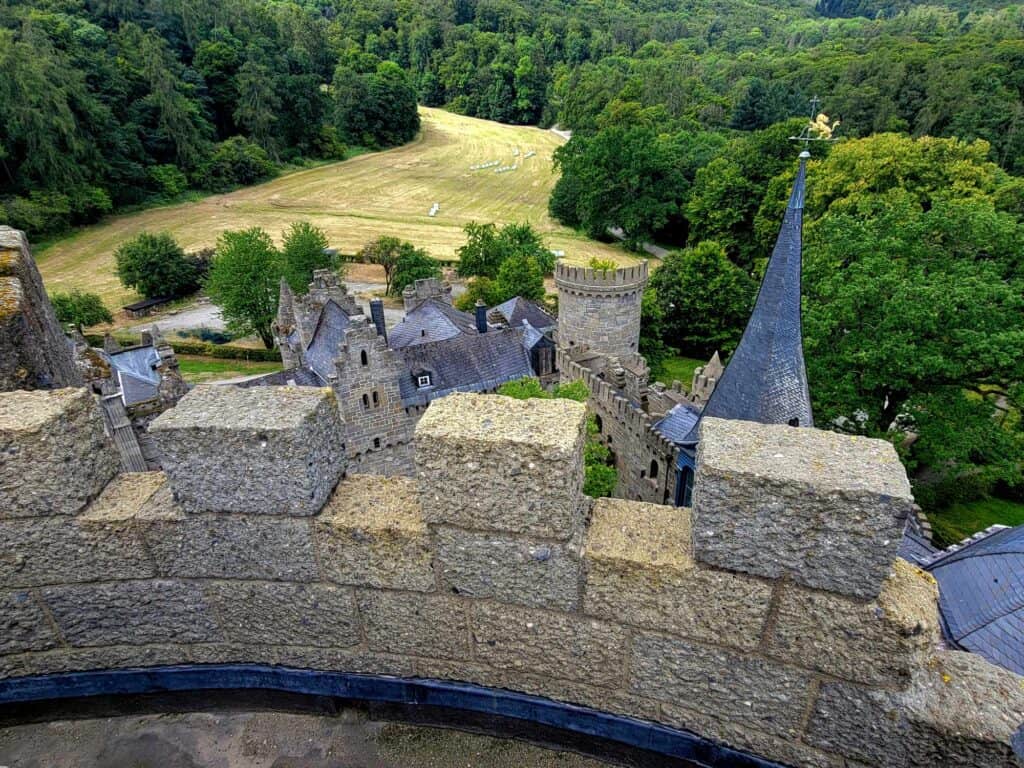
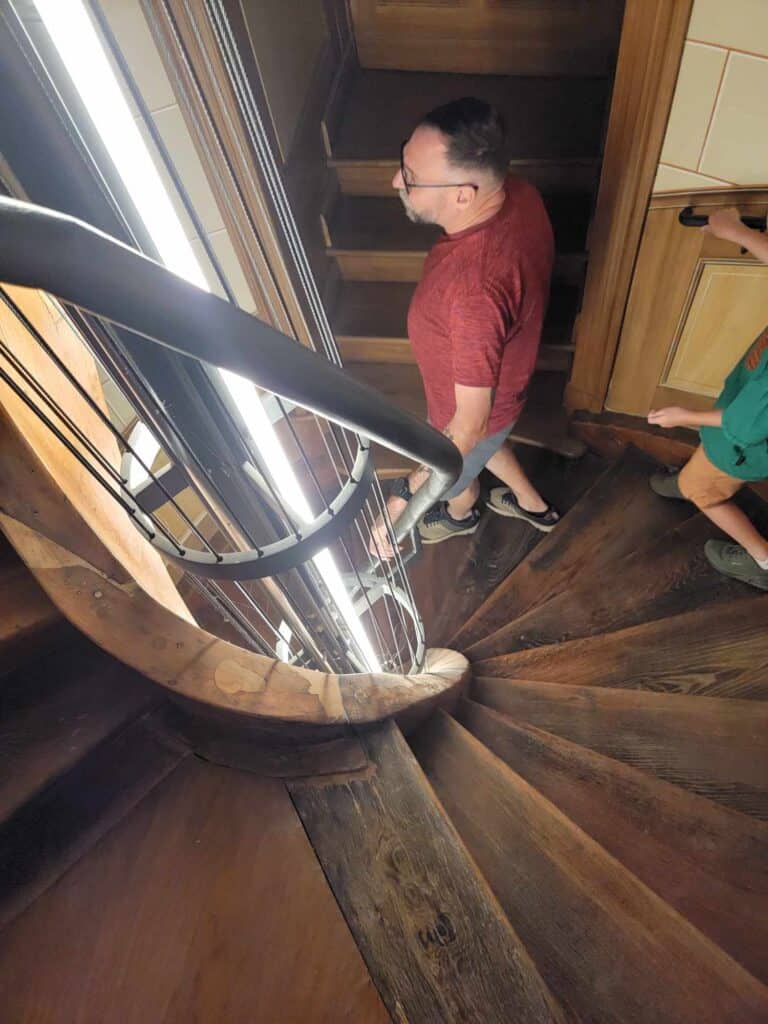
The view from the top of the keep is spectacular, and if you pay an extra 2 euros you can climb up the133 steps to look out over the countryside. Remember that your group will be small, and the steps are wide so you’ll be able to rest and take a breather if you need to.
A Love Nest
Lowenburg Castle supposedly served yet another purpose, although we didn’t see or hear much about this on the tour. William reportedly used the castle as a love nest with one Karoline von Schlotheim.
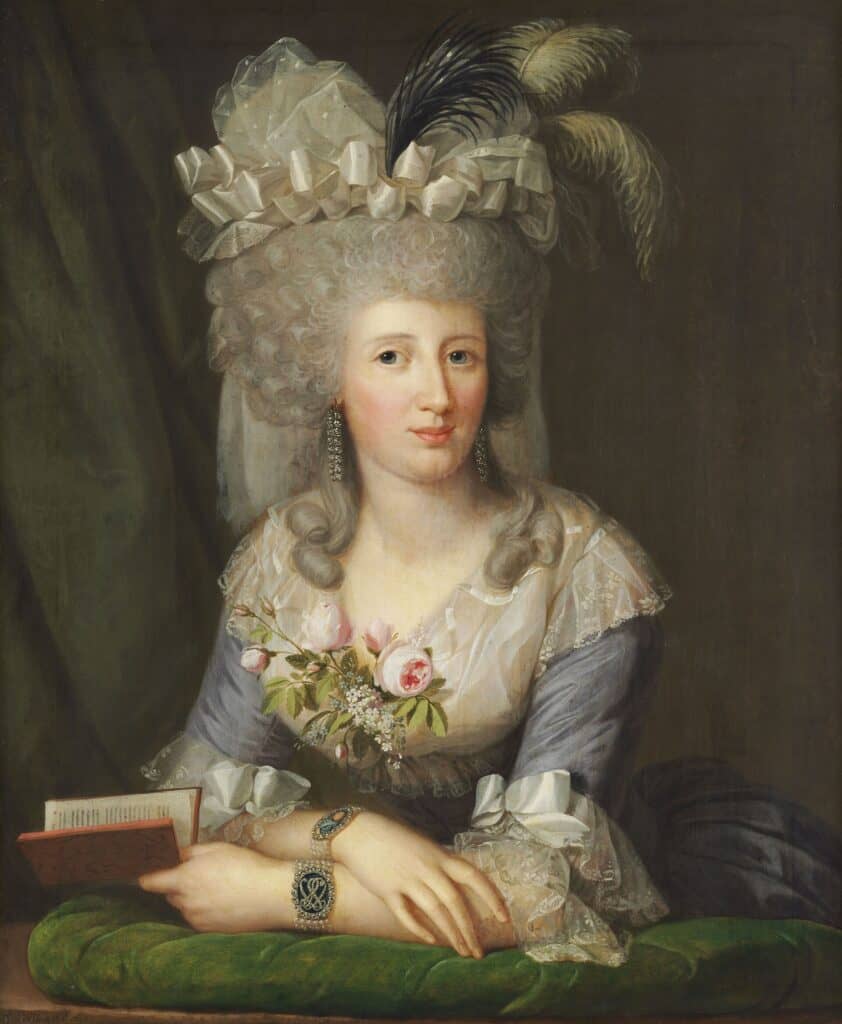
William was not only wealthy and powerful, he was a bit of a scoundrel. Karoline was not his wife. His wife was his first cousin Wilhelmina Caroline of Denmark and Norway with whom he had four children. Karoline was his third mistress in a series of three, with whom he had 13 children – 5 of whom survived to adulthood. There were two other mistresses who also bore him children, more than 2 dozen in total! His offspring were all eventually “legitimized” and received titles, and money when he died.
But back to Karoline. She was the daughter of a General, and William basically kidnapped her against her will in 1788 when she was only 22 years old. He was 45. She actually managed to escape and made it home, but her parents sent her back, and eventually she “consented to stay.” That’s what the history books tell us, but it’s hard to say how she really felt about it all. Despite the awful way it started, Karoline ended up wielding a great deal of power and political influence over the course of her lifetime.
And when Napoleon’s army briefly annexed William’s lands, she fled to exile with him, and they eventually returned back to Hesse together.
World War II
During World War II, Lowenburg Castle was heavily damaged by RAF bombers during intense Allied air raids on Kassel in 1942 and 1943. Kassel had many strategic industrial targets including manufacturing plants for tanks and aircraft. By the end of the war about 80% of the city center lay in rubble.
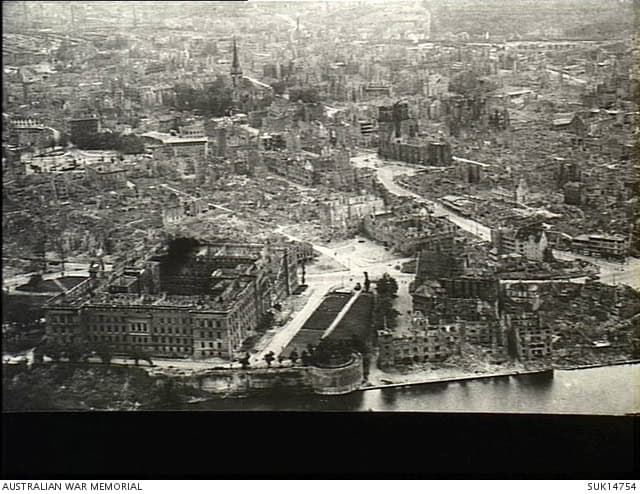
Lowenburg castle’s keep was almost completely destroyed, and several other large parts of the building were severely damaged. In 1957 during reconstruction work some inventory was amazingly recovered from the destroyed keep. But the most comprehensive reconstruction happened between 2005 and 2022. During this time a major renovation took place, completely rebuilding the keep and making it accessible once again. It wasn’t until summer of 2022 that the refurbished Lowenburg castle was opened to the public in its current form.
I was absolutely impressed at not only the initial design and construction of the “faux castle,” but of the restoration job that gave the intentional ruin its design and romantic beauty back, after it became an actual ruin during the war.
What to Expect When Visiting Lowenburg Castle
Today you can visit the castle, and walk through its rooms, almost as they would have looked during William’s time. And it’s not just the building itself, but much of the original furniture and decoration has been restored. Wall coverings and art from the original structure were saved and are on display once again, and in some places even the original intricate wood floors have survived. There are the original Belgian tapestries (which were the most costly decorations in the castle), spectacular beaded wall coverings, furniture, fabrics, oil paintings, an armory, and more.
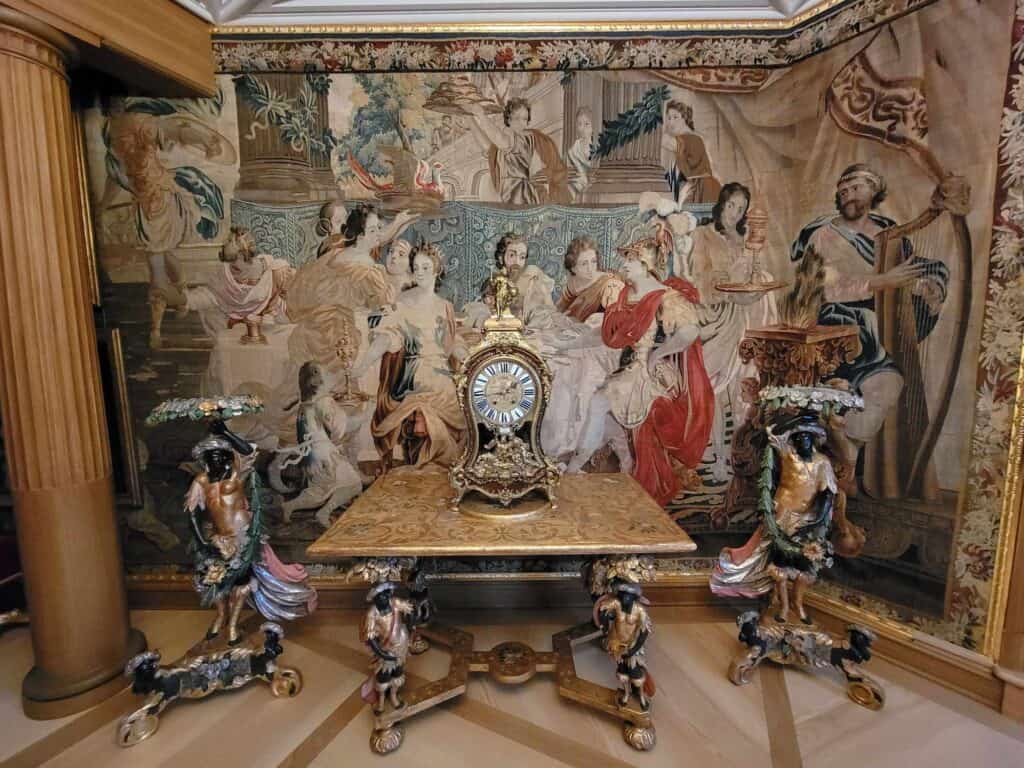
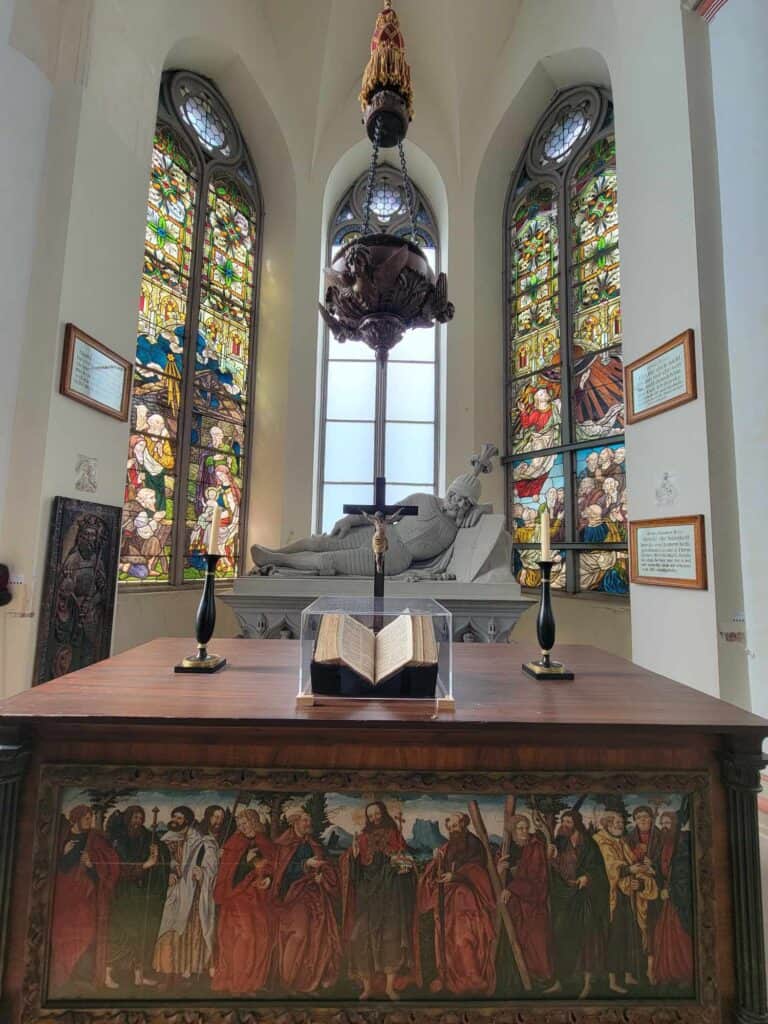
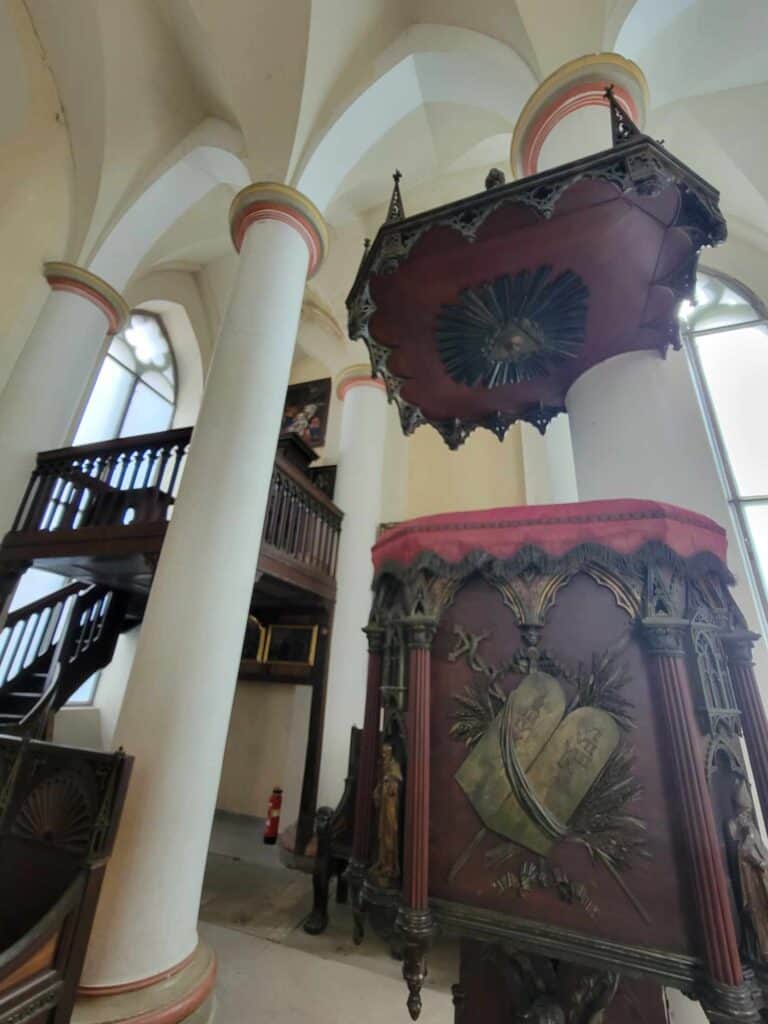
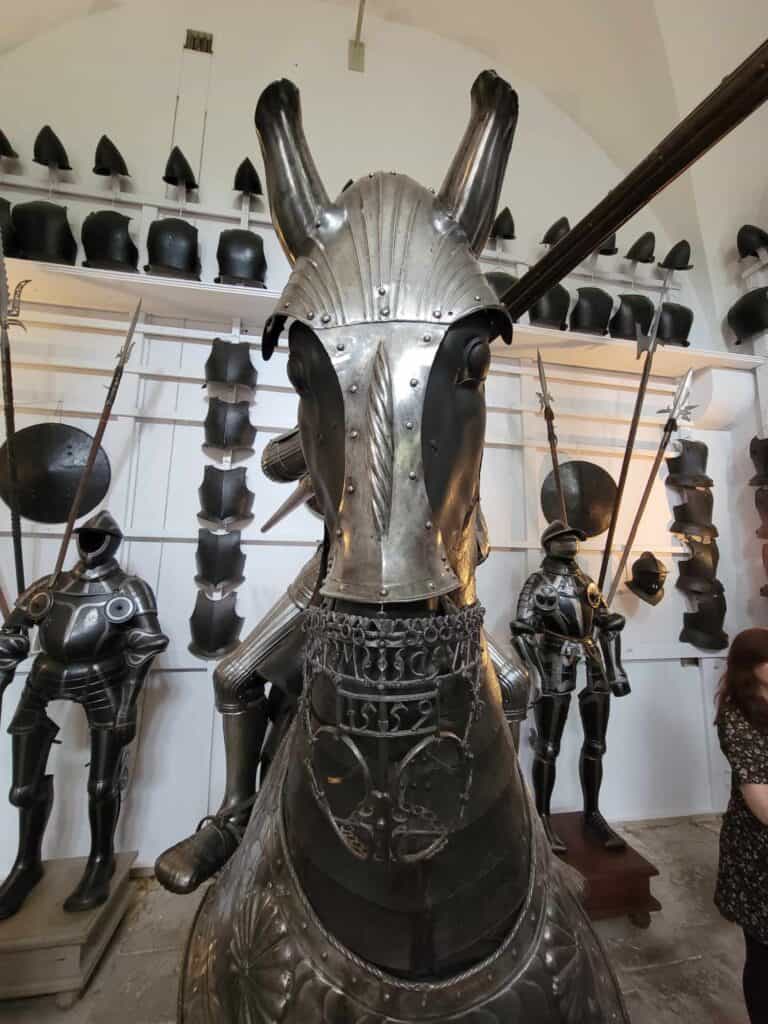
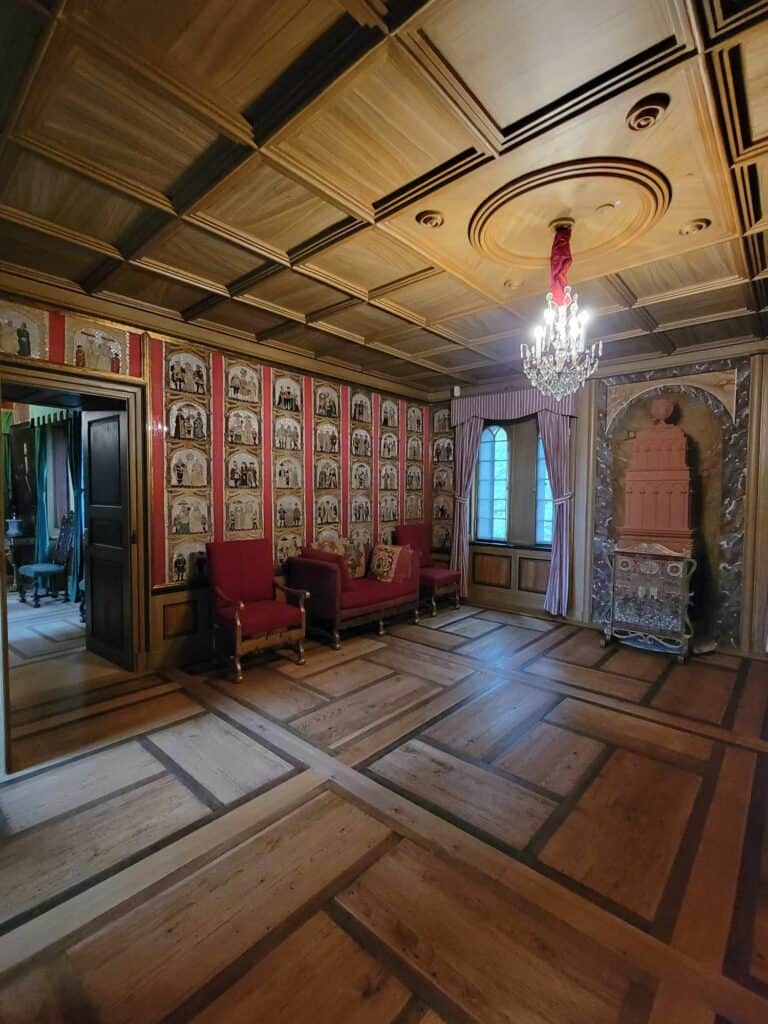
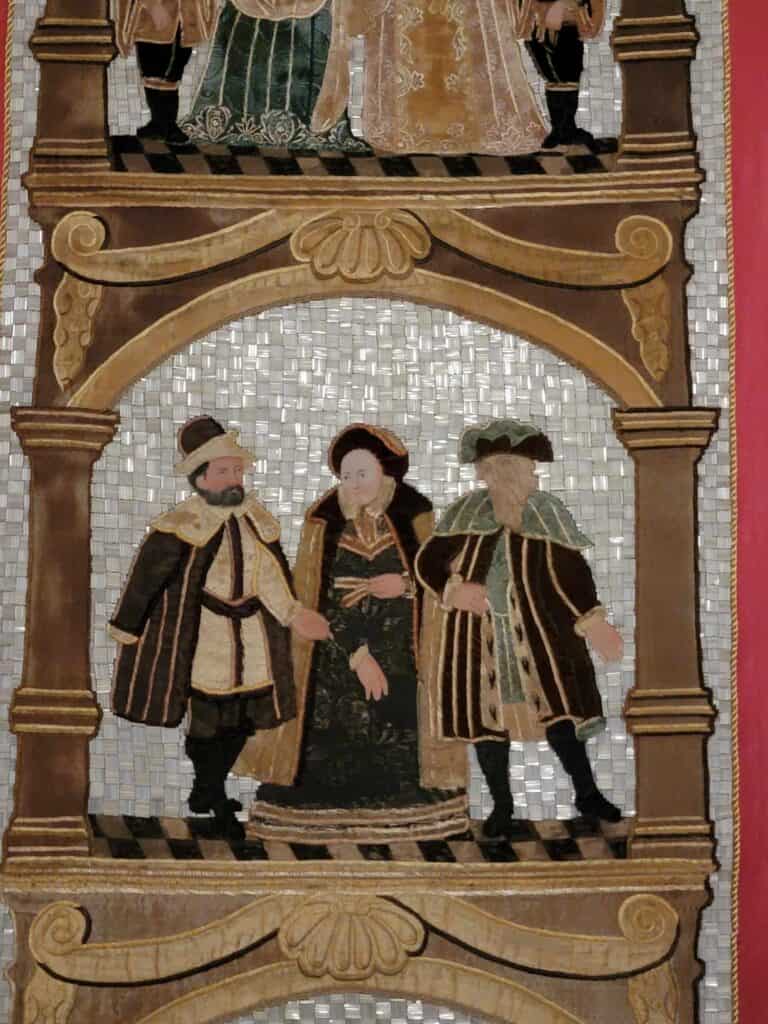
The last two photos in the gallery above show you those beaded wall coverings. They really are incredible, and I was almost mesmerized by the play of light. Each little panel shows clothing fashions through the ages, and the beadwork shimmers and dances in the light and almost looks like it’s moving.
You’ll also see the little chapel with its stained glass, lion decor, and the place where William himself was buried in the crypt in 1803.
Tickets and Tours
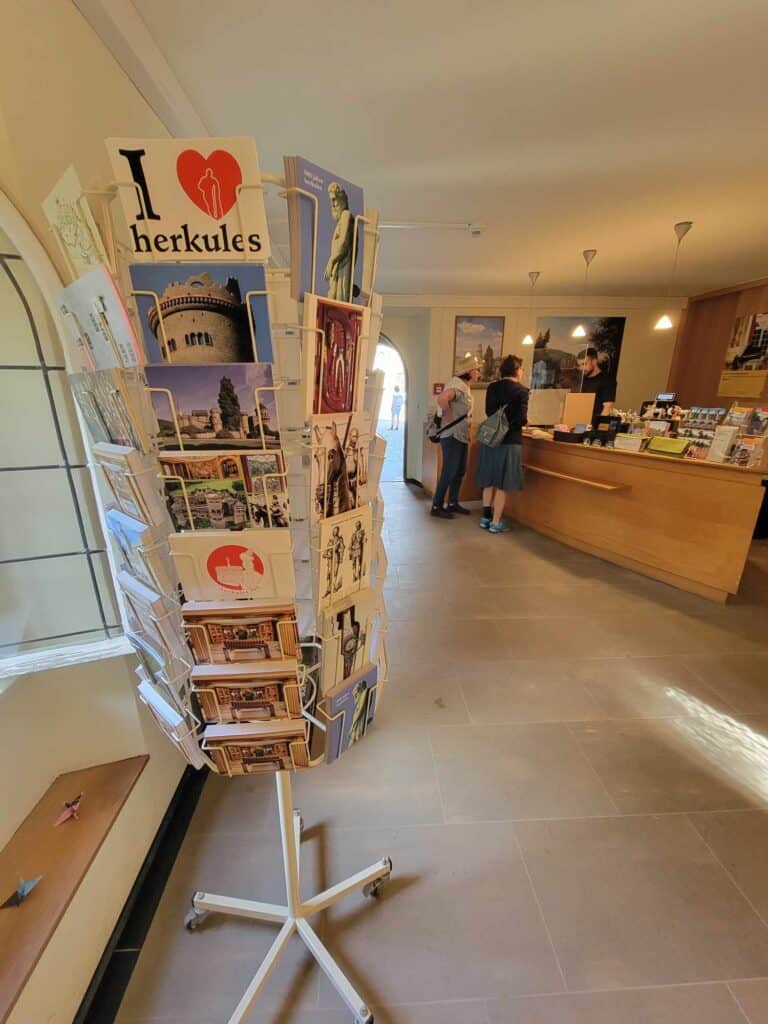
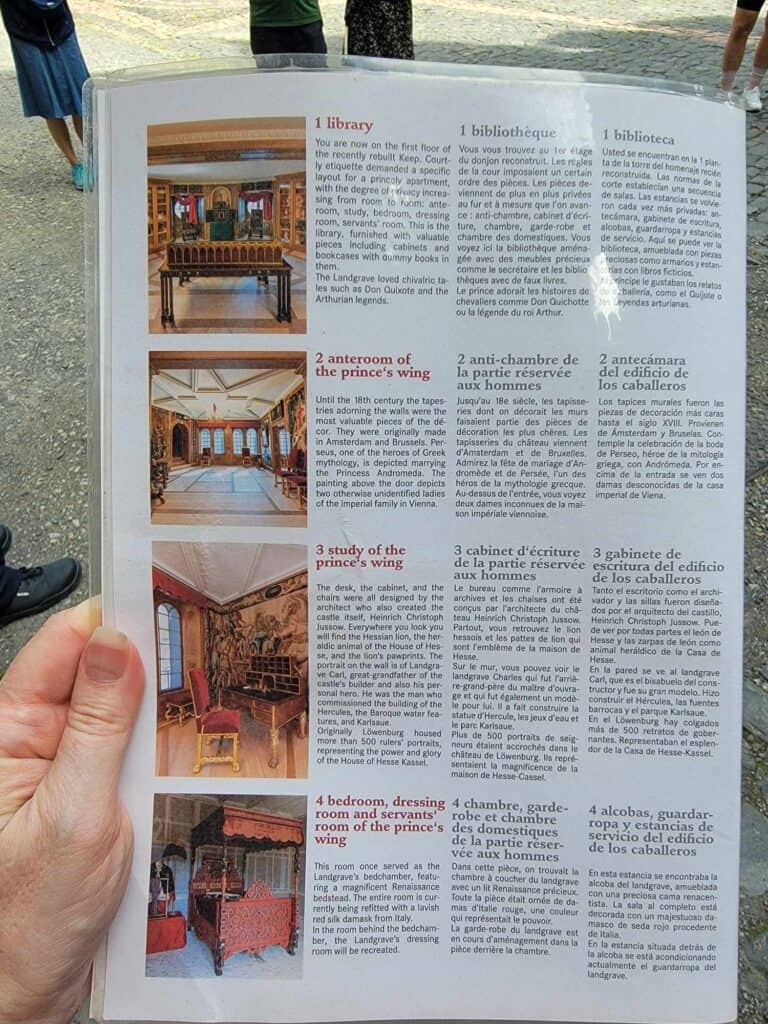
You can purchase tickets in the gift shop near the entrance to the castle, but it’s best to get your tickets online so you can be sure you have a place reserved.
Basic admission to the castle is €6 for adults, and children under 18 can enter free. If you want to climb the tower and go out on the viewing deck, add an additional €2 per person.
You can only enter the castle if you are with a tour group, but you can walk all around the outside of the castle and in the courtyard without purchasing a ticket. Tour groups include 15 people at a time and start every hour on the hour.
Unfortunately, the tours are only available in German, but you can pick up a laminated guide in English, French, and Spanish explaining all the rooms so you can read as you go. I took pictures of the guide so I wouldn’t have to carry it. The descriptions are pretty basic and brief, but it does let you know what you’re looking at, and the tour is worth taking just to be able to see the inside of the castle.
Hours of operation
The castle is open to the public Tuesday – Sunday
April 1 to October 31 and public holidays from 10am-5pm
November 1 – March 31 Friday, Saturday, and Sunday and public holidays from 10am-4pm
It’s closed on Christmas Eve, Christmas Day, and New Years Eve. Open New Year’s Day from noon to 4:00pm
Parking

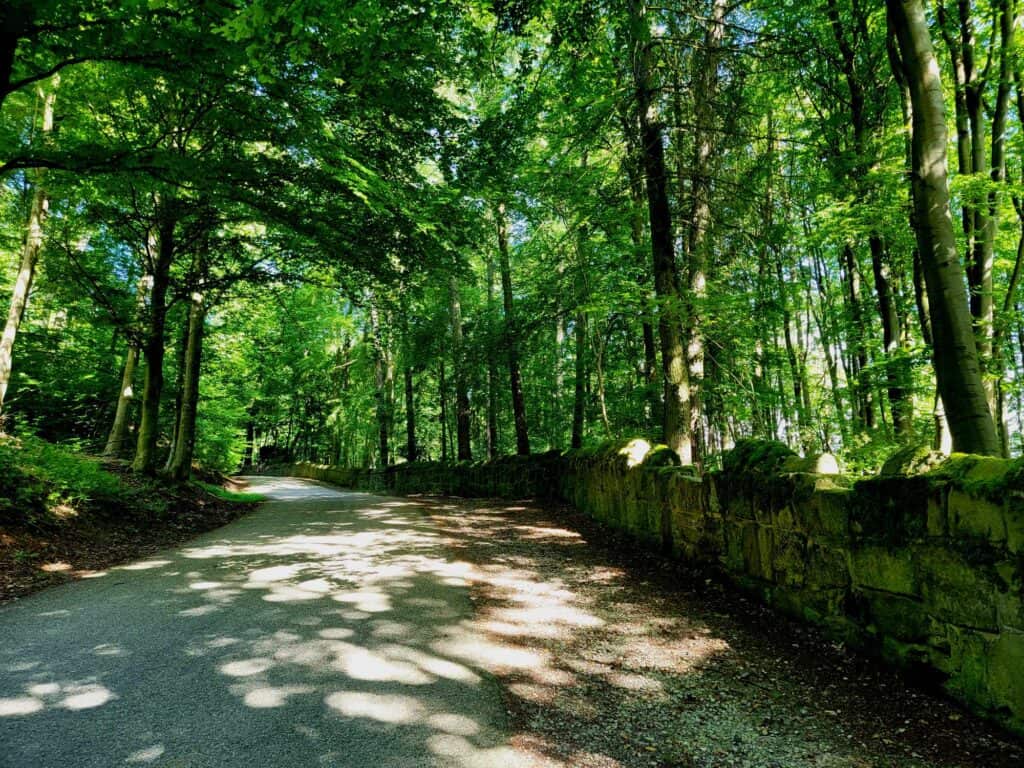

There is a large parking lot located near the entrance to the castle. You can also park down the hill by the entrance gate and take a short and beautiful meander up the hill. It takes less than 10 minutes and you can see some interesting “ruins” along the way.
Facilities
You’ll find restrooms located on the ground floor near the entrance.
There is also a locker room where you will have to secure any bags or backpacks before your tour begins. The lockers are free.
Photography
You can take as many photos as you like of both the outside and inside of the castle, but video is prohibited inside.
Food
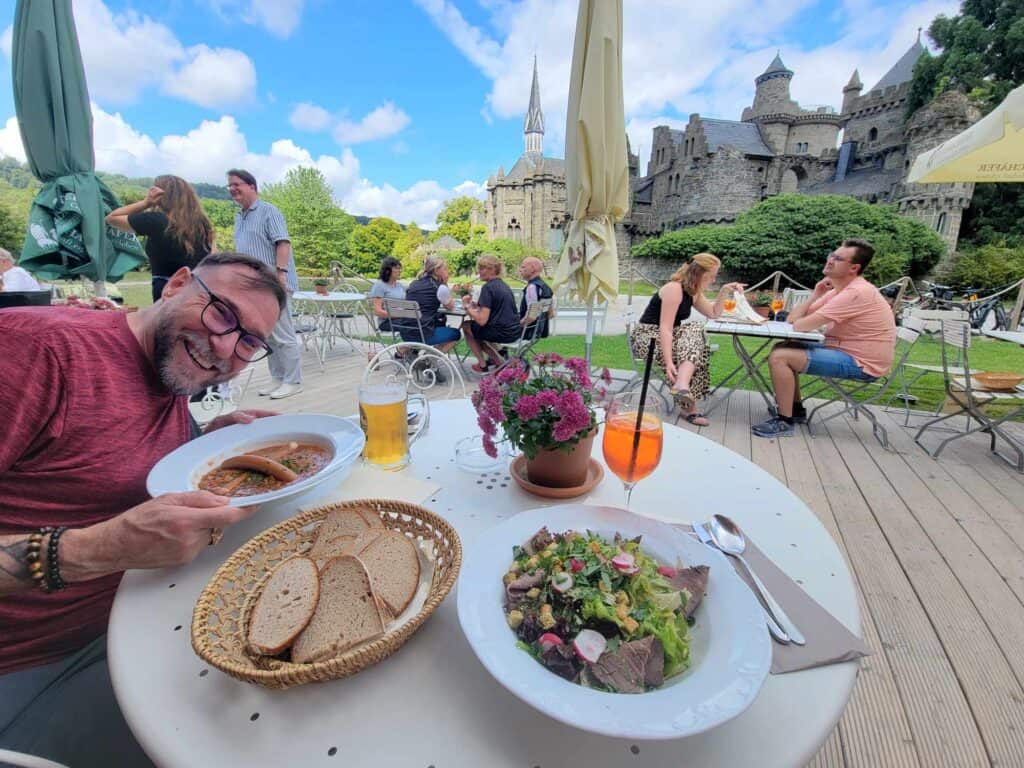
There’s a very nice little spot to sit and have a meal, snack, and/or beverage just outside the castle gate. Here’s where you can really soak in the postcard view of the outside of the castle and appreciate all that went into creating it. I can’t think of many other places with this kind of view while you eat!
I had a really nice steak and quinoa salad, and my husband was very pleased with his lentil stew and wurst which he said reminded him of the “beanie weenies” of his childhood. 😆
Weather
The castle is not air conditioned, and there isn’t a lot of air flow. So, if you are traveling in the summer, dress light! The tour is only about an hour long, but I was getting pretty warm by the end.
Rain should be no issue, though because after all that renovation, the roof is solid!
You can check the current weather conditions in Kassel here.
Random Fun Fact!
In 1922, the German silent film “So sind die Männer” also known as ‘The Little Napoleon’ that gave film legend Marlene Dietrich her first bit part was filmed partly in Lowenburg Castle!
Lowenburg Castle was a Great Place to Visit!
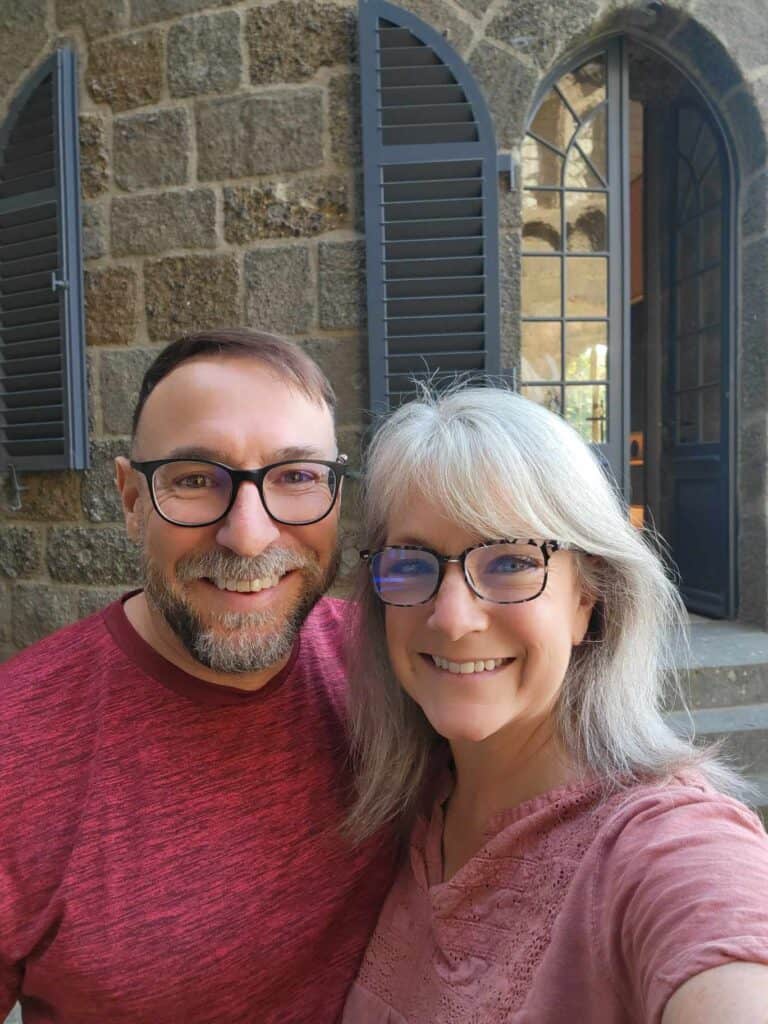
I really loved our visit to Lowenburg Castle. While it may not have played a significant role in historical events, or held knights on horseback, or defended itself in battle, it absolutely has a story to tell. I overheard a couple visitors (Europeans) mildly complaining that it really wasn’t “that old,” and I laughed to myself. As an American, even though I live in Europe, I still consider anything from the 1700s old!
And the Romantic movement and its infatuation with neo-Gothic architecture is a part of history in itself. We can look at Lowenburg Castle and get a glimpse into another world, with the the tastes and values of the 18th century. And the love of medieval aesthetics continues to this day in all kinds of modern ways. Think of the books, movies, Netflix series, and video games that bring us back to that time in some way. So go, enjoy, and immerse yourself in the world of the Landgraves, their romanticism, and the turn of the 18th century.
Sponsored content: this section contains affiliate links
*German Castle Terms and What They Mean
So, what is the German name for castle, anyway? If you’ve been to Germany, or are planning a trip, especially to Kassel, this moment of linguistics may help.
Kassel is not the German word for castle, but rather the name of the town Kassel in the German state of Hesse, which contains more than 1500 castles!
If you trace the word “Kassel” back, it does come from the Latin “Cassellum” which means “little castle town.” And while the town Kassel was named for a castle, whatever particular castle that was has been lost to history. We know that it doesn’t refer to Lowenburg castle because the town’s name existed for hundreds of years before it was built.
Schloss is a common German word for castle, but it is most often associated with a very fancy, and elegant structure. The translation to English would be more like “palace.” Think luxury, grandiosity, formal gardens, and ostentatious show of wealth.
Burg is another common German term for a castle, and it’s more like what you’d think of as the typical fairytale castle. It refers to a fortified or defensive structure. It’s often associated with a hilltop location. It might also have high walls, a moat, towers, and turrets.
Berg although it sounds the same in English as “Burg” simply means “mountain” in German. It doesn’t have any castle meaning, but since many “Burgs” are located on “Bergs” you may find them paired. And yes, there is a German town called Burgberg (Castle Mountain)!
Other Great Castles in the Area
- Explore the Astounding Schlossberg Caves and Castle Ruins in Homburg
- Ultimate Guide to Frankenstein Castle in Frankenstein Germany
- Hike to Hohenecker Castle in Kaiserslautern Germany
- Explore Fascinating Nanstein Castle in Landstuhl Germany
- Stahleck Castle in Bacharach: A Gorgeous Hike with a Dark Past
- Discover Charming Hohenbaden Castle Overlooking Baden-Baden
- A Real-Life Fairytale Castle in Germany – Discover Miraculous Burg Eltz
- Saarbrücken Castle – Explore this Fascinating Underground World
- Your Ultimate Guide to Visiting Nuremberg Castle: History, Tips & Must-Sees
